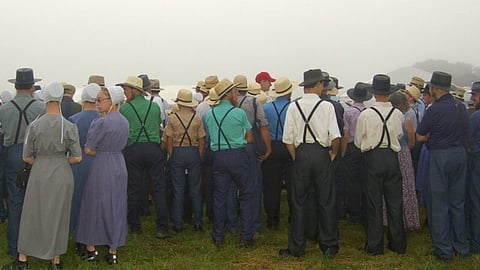
- Home
- NG Hindi
- India
- World
- Politics
- Sex & Relationships
- Entertainment
- Culture
- Lifestyle
- Economy
- Sports
- Sp. Coverage
- Misc.
- NewsGram Exclusive
- Jobs / Internships

The Mennonites reject modern life, living by a strict interpretation of the Bible.
Their community thrives on farming, discipline, and strong family values.
They preserve a centuries-old way of life rooted in faith and simplicity.
Mennonites, one of the most mysterious communities in America, are still living life as in the 1800s - with no internet, no higher education, and away from modern conveniences that define daily life. Their customs trace back to the 17th and 18th centuries with the arrival of their ancestors in America. They maintain their distance from the general population by dwelling in remote rural locations in northern Wisconsin. They sustain their lives through farming, manual labour, and close community cooperation, rooting their culture in the strict interpretation of the Bible, which governs every aspect of life.
The Mennonites are among the few American groups who have made a conscious decision to keep modernity at bay. The community has not changed its traditions for generations, now farming its own food and following old routines. They believe that elements of modern culture weaken their moral principles.
Every detail of their lives is governed by their interpretation of the Bible, from daily prayers to all social interactions. They greet each other with “a holy kiss” when they meet, following the verse in 1 Thessalonians 5:26: “Greet all with a holy kiss.” For them, following the scripture in such a visible way in their daily lives shows the strength of their belief in their faith.
As far as education is concerned, it ends early in this community. There is only one school available in the community, run by the church in its basement, which only goes up to the eighth grade. The people here believe that high school and college introduce worldly concepts, distancing individuals from God. They believe that education should prepare one to serve their family, community, and church rather than focus on personal ambition.
Young members start working within the community soon after completing the eighth grade. They gain skills that help them in the future for collective sustenance by working in agriculture or local slaughterhouses. They value discipline, simplicity, and faith over material success.
Men and women sit separately during church services and prayers, even if they are from the same family. Here, gender roles are clearly defined, and this is done to ensure that each gender understands its role in the home and faith rather than to create division.
The community follows strict rules even when it comes to marriage. There is no place for dating; instead, it is replaced by courtship, and any physical contact before marriage is strictly prohibited. This is done as part of God’s guidance to understand shared goals and compatibility rather than for romantic exploration. They follow the rule of “one mate for life,” and marriage is seen as a lifelong commitment between a man and a woman, ending only at death.
Families here are often large, with over fifteen children and hundreds of grandchildren. Homes are painted in shades of pink and purple and are designed to accommodate large families. A symbol of their communal living is the restroom walls adorned with toothbrushes for all the children in the family.
Families usually eat together at the table, making it a moment of faith and thankfulness. Every member prays together, and their prayer goes as follows: “Our Heavenly Father, we thank you for your great goodness to us. We thank you for the beautiful day. Thank you for the food when many in this world are hungry. We pray that we would remember that these gifts are from you. Amen.” They live by the rule of self-sufficiency, growing and canning their own food rather than relying on external supply chains. Their daily life revolves around simplicity and gratitude.
They describe their life as a battle, one that requires constant struggle against selfishness, greed, and temptation. They enforce moral discipline, and even offenses such as pornography lead to immediate action. The person is counseled and given the choice between staying in the community by opting to change or leaving if they cannot. Members must follow the Bible not just in public but also in private life, reflecting purity and moral clarity.
The epicenter of Mennonite life is the Sunday service, which amazes outsiders with the sincerity and unity of the community. The choir songs reflect devotion and humility, filling the church hall with hymns. Every aspect of worship aims to remind people of their mission to live for God, from singing to prayer. It is an essential part of their social and spiritual life rather than an option.
The Mennonites’ way of life may seem extreme from others’ perspectives, but for them, these choices represent a path to righteousness. This may appear as if they are stuck in a bygone era, but it is their conscious act of faith and spirituality.
The Mennonites of northern Wisconsin continue to stand as a model of religious endurance in a time of rapid technological change. They live quietly, maintaining a way of life deeply rooted in beliefs formed centuries ago. They measure progress through faith, work, and community rather than machines and degrees. Their presence raises the question of whether modernity always leads to betterment. They have preserved a parallel America characterized by faith, conviction, and simplicity. [RhOG/SY]
Suggested Reading:
